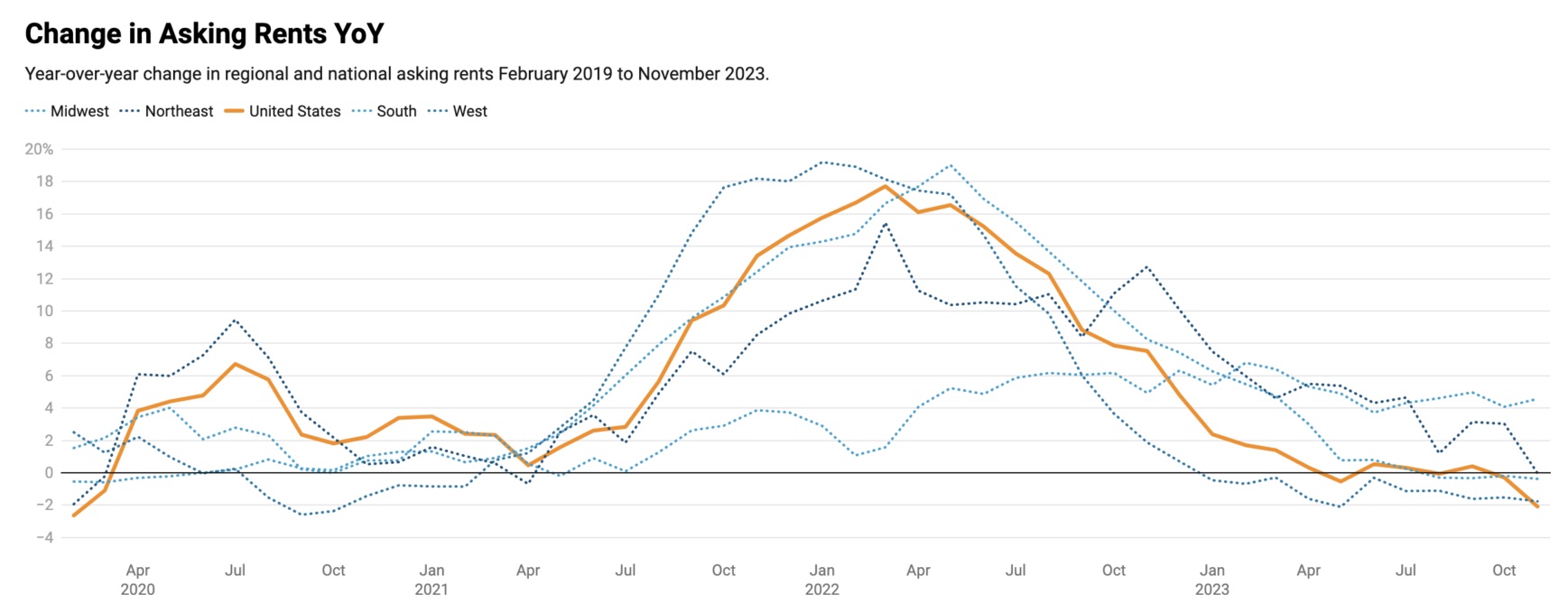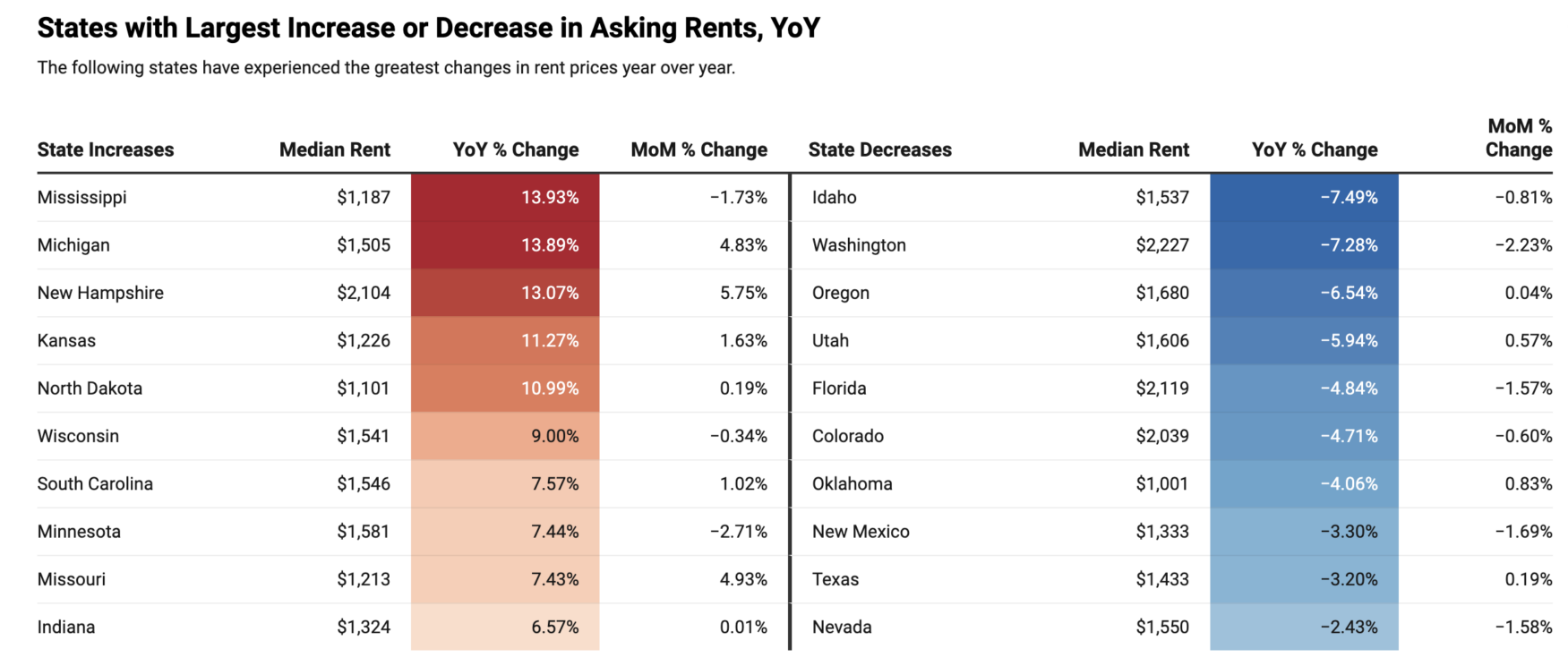A new study from Rent. revealed yearly declines in asking rents accelerated in November, dropping more than 2% from this time last year. This represented the second month in a row, and the third time in the last four months, that prices dropped on an annual basis.
November’s -2.09% decline was significantly larger than the most recent price drops. Yearly declines in October were just below one-third of 1%, while declines in July were minimal at just -0.06%.
November was also the first time in more than three and half years that year-over-year prices dipped by more than a single percent. In February 2020, prices dropped by more than 2%. A month later, as the pandemic took hold across the country, prices declined again in March 2020, this time by -1.09%. That cooling trend was short lived and following those late-winter declines, national prices rose on a yearly basis for 37 consecutive months.

It wasn’t until May 2023 that yearly prices shrank again. Over that time, asking rents grew by more than 20%, from $1,614 in March 2020 to $1,967 in May 2023.
The current national median price is also $1,967. Prices peaked in August 2022 at $2,054.
On a monthly basis, prices declined for a third consecutive month, but declines from October to November slowed. Current asking rents decreased -0.57% month over month compared to a -1.64% decline from September to October and a more than 2% drop from August to September. Rents have now declined in six of 11 months in 2023.
Despite the slowdown, another monthly drop is further evidence that rent prices are returning to cyclical patterns that eluded the market during the pandemic. September 2022 was a mile marker in rent prices, ending a run of double-digit yearly gains that began in October 2021.
Over that time, rents rose by over 11.5%, climbing from $1,839 to $2,054 in August 2022. Prices in September were still up 8.83% but began a decline—led by decreased demand—which lasted until rents bottomed out at $1,937 in February 2023.
Price levels rose steadily from February before peaking in August, gaining nearly 6% and coming within $2 of the historical high. Declines since August have brought that growth down to just over 1.50% and decreased prices from August's peak by $85.
On a longer-term basis, rents remain elevated. Since November 2019, months before the pandemic, prices have risen by more than 22%, adding $355 to monthly rent bills.
National Rent Price Trends
- Price growth at the national level continues to be held down by below-normal demand, increased inventory, and a return to seasonal price trends that typically place downward pressure on rents through the fall and winter.
- November’s greater than 2% annual decline marks the second month in a row that prices dropped on a yearly basis after peaking last August. Asking rents have now declined year-over-year in three of the last four months and a total of four times in 2023.
- Price growth over this year stands at 1.29%, rising from $1,942 in January to the current price of $1,967.
- Monthly price changes registered negative for the third month in a row. The -0.57% decline from October to November was smaller than both the 2% decline from August to September and the -1.64% decline from September to October, but added to evidence that the national market has returned to seasonal trends.
Prior to recent declines, prices had been generally rising since February, gaining nearly 6% until prices peaked in August.
Regionally, prices continued to climb in the Midwest. Yearly growth there increased from 4.08% in October to 4.57 percent in November. Asking rents, however, remain well below those in other regions. At $1,434 in the Midwest, it is still nearly $1,000 cheaper than median rents in the Northeast and West and nearly $200 less than rents in the South.
All other regions saw year-over-year declines in November. This was a reversal for the Northeast, which grew by more than 3% on a yearly basis in October. The region is now down 0.02% year-over-year. Declines in the South were relatively minimal at -0.37%, but nearly doubled from a month ago, when yearly declines were just under -0.20%. Asking rents in the West continue to decline, which in recent months has been driven by locales in the Mountain West. The region’s asking rents dropped another -1.76% in November after October’s -1.52% decline.

State Rent Price Trends
State-level markets maintained a nearly 60/40 split between yearly price gains and declines. In November, 57.14% of state markets were up year-over-year compared to 40.48% of markets that showed yearly loses. On a monthly basis, the split was more even with 52.38% of markets declining to 47.62% of markets gaining over asking rents at this time last year.
States experiencing the largest year-over-year increases were led again by Mississippi. After posting an 18.3% year-over-year increase in October, yearly growth in the Magnolia State fell just short of 14% in November, despite a -1.73% decline month-over-month.
Still, Mississippi remains relatively affordable. At $1,187, asking rents there are lower than any other state among the largest gainers except for North Dakota, where rents rose by nearly 11% year-over-year to $1,101. South Carolina was the only other Southern state among the largest gainers, with a 7.57% yearly increase. Asking rents, there are now $1,546.
Reflecting regional trends, the Midwest once again dominated the list of states with the highest yearly increases, with seven of the top 10 largest gainers coming from the region. North Dakota was joined by Michigan, which had the second largest yearly gain at 13.89%, Kansas, with growth north of 11%, and Wisconsin, which grew by 9%.
The list of largest gainers was rounded out by Minnesota, Missouri, and Indiana, all of which grew between 6.50 and 7.50% year-over-year.
New Hampshire was the only Northeastern locale on the list. The Granite State grew by more than 13% year-over-year and gained 5.75% from October to November to a median asking rent of $2,104.
The West, particularly the Mountain West, led yearly declines in November.
Hot metros like Boise, Idaho, that saw significant increases in inbound migration and rent prices over the pandemic have been cooling for months. Those declines have translated to a -7.49% state-wide decrease in asking rents across Idaho, which saw the largest year-over-year declines. Four more Mountain West states also saw relatively large yearly losses, including Utah, Colorado, New Mexico, and Nevada.
In the Pacific Northwest, both Washington and Oregon saw yearly declines at -7.28% and -6.54%, respectively. Declines in Washington were led by eastern metros like Spokane, which has declined by nearly 14.5%, or $282, since asking rents reached their highest level on record in June 2022. In contrast, declines in Oregon were driven by western metros like Portland, which saw the largest yearly decline in November.
Florida, Oklahoma, and Texas were also among the largest losers. All three declined between three and five percent year over year. Price slides in Oklahoma ensured its position as the cheapest metro in this study, coming in at $1,001.

Metro Rent Price Trends
Positive changes at the metro level were led by the Providence, RI metro. Asking rents there increased by 22.32% on a yearly basis, and just over one-half of 1% month-over-month. Providence is now the ninth most expensive metro in this study at $2,846, placing it between Seattle and Riverside, CA.
The New York City metro was the only other Northeastern city among the largest gainers. Perennially the most expensive metro in the nation, asking rents across the metro rose 5.19% on a yearly basis, while declining nearly 3% month-over-month to $4,218.
Helping propel Midwestern gains in November was the Columbus, OH, metro. With an 11.24% increase year-over-year, Columbus saw the second highest yearly gains among metros in this study. Prices there are now $1,732. Joining Columbus were regional neighbors Kansas City—the third highest yearly gainer at 9.71%—along with the Indianapolis and Cincinnati metros, which each grew by more than 5% year-over-year.
In the West, Phoenix, San Jose, and Los Angeles metros all showed large gains. San Jose now ranks as the third most expensive metro in this study at $3,682, followed by Los Angeles at number five, where asking rents are $3,595. Rents in Phoenix are now $2,178.
Metro declines were led by the Portland, OR, metro, where a more than 10% daily drop left asking rents at $2,285. Sacramento, CA, saw metro rents fall by more than nine percent to $2,488. In the Mountain West, asking rents in Salt Lake City and the Las Vegas metro declined by -7% and -8.50%, respectively. Asking rents in those areas are now $1,753 and $1,655.
Prices in the Miami metro dipped by -9.72%, the second largest yearly decline among metros in this study. Despite its steep drop, asking rents in Miami are the seventh highest among metros in this study. At $2,950, Miami ranks as the highest-priced southern metro. Across the South, asking rents in Raleigh, NC, Austin, TX, Memphis, TN, Nashville, TN, and Houston declined between four and nine percent on a yearly basis.
To read the full report, including more data, charts, and methodology, click here.

 DSNews The homepage of the servicing industry
DSNews The homepage of the servicing industry









